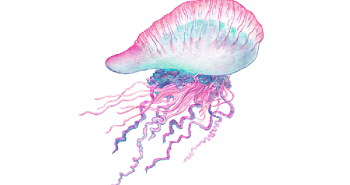
Portuguese man o’ war
(Physalia physalis)
Although the Portuguese man o’ war looks like a single animal, it is in reality a colony of animals called polyps that belong to the group known scientifically as Siphonophorae.
As opposed to most known true jellyfish, the specialised polyps of siphonophores form a large free-floating community (or colony) and are connected to one other by a shared digestive system.
Portuguese man o’ wars spend most of their life on the surface. The “sail” of these animals is an air sac filled with gases created by specialised polyps, allowing it to drift with surface winds on the surface.
The actual colony lives at the interface and below the surface. Since they are not able to actively swim against the currents, these animals are referred to as plankton (in contrast to mobile species that can move against the current, such as dolphins, which are referred to as nekton) Strong winds at sea sometimes blow Portuguese man o’ wars into bays or out on bathing beaches.
General information
Further names: Portuguese: Caravelas
Prey: Mainly fish and crustaceans
Habitat and range: They are found in all warm regions of the world’s oceans. They most commonly occur in the tropical and subtropical regions of the Pacific and the Indian Ocean, and in the Gulf Stream in the Northern Atlantic.
Distinctive features: The Portuguese man o’ war looks like a large bladder with very long tentacles. This large bladder, also called the “sail”, reaches a considerable length ranging from 9 to 30 cm and a width of 10 cm. It is filled mostly with carbon monoxide and nitrogen. There are tentacles on the underside of the bladder which can be stretched out horizontally and can reach a maximum length of 50 metres. However, they are usually not longer than 10 metres.
Taxonomy: Class: Hydrozoa; Order: Siphonophorae; Genus: Physalia
Enemies: Despite their powerful venom, Portuguese man o’ wars are eaten by other animals. These include the Loggerhead sea turtle (Caretta caretta), a nudibranch known as the Blue Dragon (Glaucus atlanticus), the Common violet snail (Janthina janthina) and the Common blanket octopus (Tremoctopus violaceus).
Venom: Touching the tentacles often causes intense pain in humans. Red welts appear on the skin which usually only fade after 2 to 3 days. The pain subsides after about an hour. If the venom gets into the lymph nodes, the pain may be more severe. Contact with the stinging cells may also trigger an allergic reaction, which can have serious effects, such as fever, shock or rapid heartbeat. In rare cases, the sting may be lethal. Medical treatment is important especially in cases where severe pains persist and/or a red streak develops between a swollen lymph node and the sting or if the affected area is red and warm to the touch.
